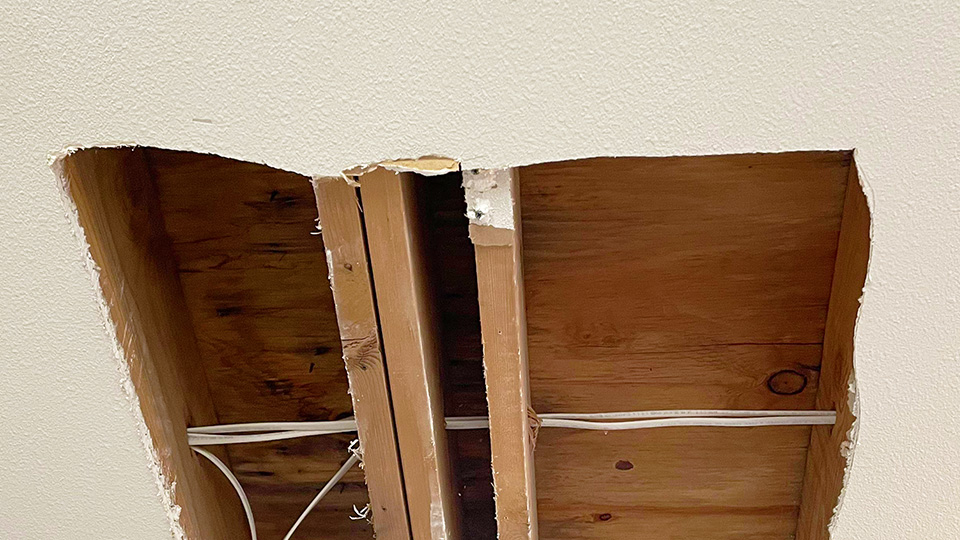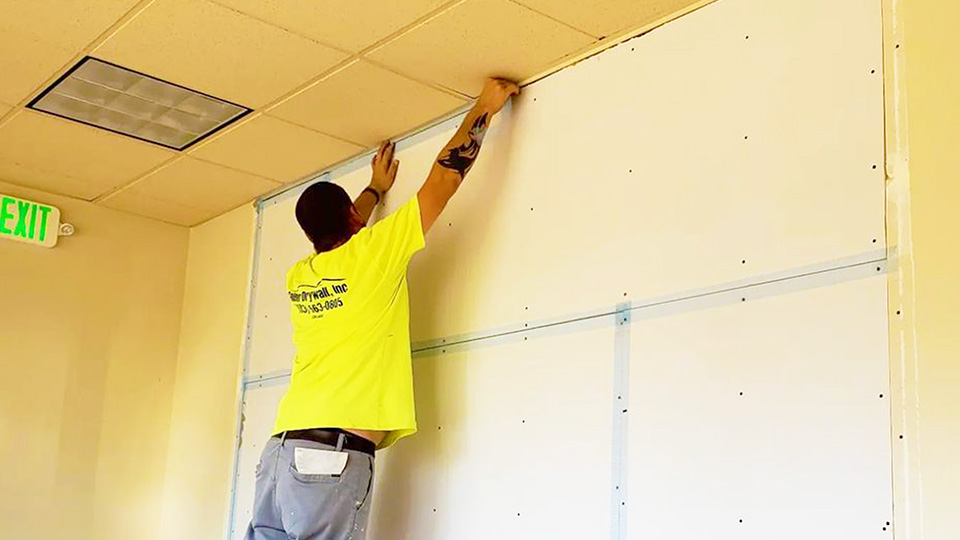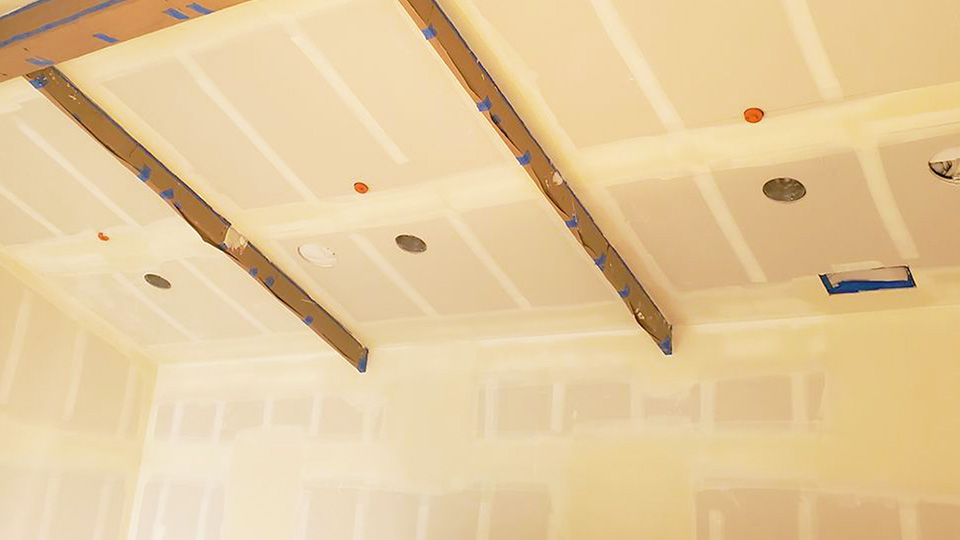Need Drywall Repair in Vancouver to Abbotsford – Click Here >
Ceiling Texture Removal and Repair >
Textured Ceiling Crack Repair >
Popcorn Ceiling Repair and Repainting >
Textured ceilings, commonly referred to as popcorn or cottage cheese ceilings, were a popular design choice in the mid-20th century. They were known for their ability to hide imperfections and provide soundproofing. However, these textured ceilings are now often viewed as outdated, leading many homeowners to consider removing, repairing, or modernizing them. In this comprehensive guide, we’ll explore various aspects of textured ceilings, including patching, removal, modernization, costs, and more.
Can a Textured Ceiling Be Patched?
Patching a textured ceiling is possible, but it requires careful attention to detail. The key challenge is matching the texture to the existing ceiling. For small cracks or holes, a DIY approach using joint compound and texture sprays can work. However, larger patches or repairs require more skill, and it’s often best to hire a professional. When patching, ensure the surface is clean and dry before applying the patching material. After patching, you may need to repaint the entire ceiling to ensure a consistent look.
Is It Expensive to Remove Textured Ceiling?
The cost of removing a textured ceiling varies depending on several factors, including the size of the area, the type of texture, and whether asbestos testing is required. The typical range for popcorn ceiling removal is $1 to $2 per square foot, but it can be higher if asbestos is found. Asbestos was commonly used in textured ceilings until the late 1970s, so professional asbestos testing is essential before any removal work. If asbestos is detected, removal becomes more costly due to safety regulations.
How Do You Modernize a Textured Ceiling?
Modernizing a textured ceiling can involve various approaches. Some common methods include:
- Skim Coating: This involves applying a thin layer of joint compound over the existing texture to create a smooth surface. It’s a cost-effective way to modernize a ceiling without complete removal.
- Drywall Installation: Covering the existing textured ceiling with new drywall creates a fresh, smooth surface. This method is more expensive but provides a clean and modern look.
- Ceiling Tiles: Installing ceiling tiles can cover textured ceilings without removing them. This approach can add decorative elements to the ceiling while hiding the texture.
- Paint and Lighting: A fresh coat of paint and updated lighting fixtures can significantly modernize the appearance of a textured ceiling.
Who Removes Textured Ceilings?
Professional contractors specializing in ceiling work typically handle textured ceiling removal. It’s crucial to hire licensed and insured professionals, especially when asbestos testing and removal are involved. Contractors with experience in textured ceiling removal will have the necessary equipment and expertise to complete the job safely and efficiently.
How Much Does It Cost to Have Someone Texture a Ceiling?
The cost to texture a ceiling depends on the type of texture and the area to be covered. Common textures include knockdown, orange peel, and slap brush. The typical range for texturing a ceiling is $1 to $2.50 per square foot. The price may vary depending on the complexity of the texture and labor costs in your region.
How Much Does Labor Cost to Remove Textured Ceiling?
Labor costs for removing a textured ceiling can vary based on the complexity of the job and local labor rates. The typical labor cost for popcorn ceiling removal is $1 to $2 per square foot, excluding additional costs like asbestos testing, material disposal, and repainting. If asbestos is involved, the labor cost can increase due to additional safety precautions and specialized equipment.
Can You Smooth Over a Textured Ceiling?
Yes, you can smooth over a textured ceiling through skim coating. This process involves applying a thin layer of joint compound over the existing texture, then sanding it down to create a smooth surface. Skim coating is often used to modernize textured ceilings without complete removal. It requires skill to ensure a consistent finish, so it’s recommended to hire a professional for larger areas or complex textures.
What Ceiling Texture Is Most Popular?
Popular ceiling textures include knockdown, orange peel, and slap brush. Knockdown texture features flattened peaks, giving it a unique look. Orange peel resembles the skin of an orange with a subtle, bumpy texture. Slap brush creates a more pronounced texture with dramatic patterns. The choice of texture depends on personal preference and the desired aesthetic. For a smoother look, knockdown and orange peel are popular options.
Is It Cheaper to Cover or Remove Popcorn Ceiling?
Covering a popcorn ceiling is generally cheaper than removing it, especially if asbestos is involved. Options for covering include installing drywall or ceiling tiles. These methods avoid the need for asbestos removal and create a smooth surface. Removing a popcorn ceiling requires extensive labor, asbestos testing, and disposal, making it more expensive. However, removing the ceiling can increase home value and provide a cleaner, more modern look.
What Is the Easiest Way to Remove Textured Ceiling?
The easiest way to remove a textured ceiling involves wetting the surface to soften the texture, then scraping it off with a drywall scraper or putty knife. This method works well for non-asbestos textured ceilings. If asbestos is present, professional removal is required due to safety regulations. For DIY removal, ensure proper ventilation and use safety equipment like masks and goggles.
Is It Better to Have a Smooth or Textured Ceiling?
The choice between a smooth or textured ceiling depends on personal preference and home style. Smooth ceilings offer a modern and clean appearance, while textured ceilings can add character and hide imperfections. In contemporary designs, smooth ceilings are more popular due to their sleek look. Textured ceilings can be beneficial in traditional or rustic settings, providing a unique aesthetic.
How Do You Remove Heavily Textured Ceilings?
Removing heavily textured ceilings involves a similar process to removing light textures but may require more effort. Wetting the surface and scraping with a drywall scraper is the standard method. For heavily textured ceilings, additional passes may be needed to remove all texture. If the texture is particularly thick, power sanding or professional removal might be necessary. Asbestos testing is recommended before attempting any removal.
Are Textured Ceilings Dated?
Textured ceilings are often considered dated, especially popcorn or heavy cottage cheese textures. These styles were popular in the 1960s and 1970s but have since fallen out of favor. Modern interior design trends lean towards smooth ceilings for a clean and contemporary look. However, textured ceilings can still be appropriate in specific contexts, such as vintage or retro-themed interiors.
How Much Does It Cost to Repair Drywall Ceiling Texture?
The cost to repair drywall ceiling texture depends on the extent of the damage and the type of texture. Minor repairs, like small cracks or holes, can cost $100 to $300. Larger repairs, like significant cracks or water damage, can range from $300 to $1,000 or more. If repainting is required, this can add to the overall cost.
Can You Skim Coat a Textured Ceiling?
Yes, you can skim coat a textured ceiling to create a smooth surface. Skim coating involves applying a thin layer of joint compound over the existing texture, then sanding it down for a smooth finish. It’s a popular method for modernizing textured ceilings without complete removal. Skim coating requires skill and patience, so it’s often best to hire a professional for a consistent result.
How Much Does It Cost to Skim Coat a Textured Ceiling?
The cost to skim coat a textured ceiling depends on the area to be covered and the labor involved. The typical range for skim coating is $1 to $1.50 per square foot, but this can vary based on local labor rates and the complexity of the texture. Additional costs may include sanding and repainting, which can increase the overall price.
How Can I Cover a Textured Ceiling Without Removing It?
Covering a textured ceiling without removing it is possible through several methods:
- Drywall Installation: Installing new drywall over the existing textured ceiling creates a smooth surface. This method is more expensive but provides a clean and modern look.
- Ceiling Tiles: Installing ceiling tiles can cover the texture while adding decorative elements to the ceiling. This approach is cost-effective and avoids the need for complete removal.
- Skim Coating: Applying a thin layer of joint compound over the existing texture to create a smooth surface is another way to cover a textured ceiling without removing it.
What Are the Disadvantages of Skim Coat?
Skim coating has several disadvantages:
- Labor-Intensive: Skim coating requires significant labor, including multiple layers of joint compound and extensive sanding.
- Dust and Mess: Sanding creates a considerable amount of dust, requiring proper ventilation and cleanup.
- Skill Requirement: Achieving a smooth finish with skim coating requires skill and experience. Uneven application can result in an inconsistent look.
- Cost: While skim coating can be cost-effective, the labor-intensive nature can make it more expensive than other methods.
How Do You Smooth a Bumpy Ceiling?
To smooth a bumpy ceiling, you can follow these steps:
- Preparation: Clear the room of furniture and cover the floor with drop cloths. Ensure proper ventilation and wear safety gear.
- Wet the Surface: Use a spray bottle to wet the bumpy areas, softening the texture for easier removal.
- Scraping: Use a drywall scraper or putty knife to remove the bumps. Work in small sections for better control.
- Skim Coating: Apply a thin layer of joint compound over the scraped area to create a smooth surface.
- Sanding and Painting: Once the skim coat is dry, sand it down to achieve a smooth finish, then repaint the ceiling.







